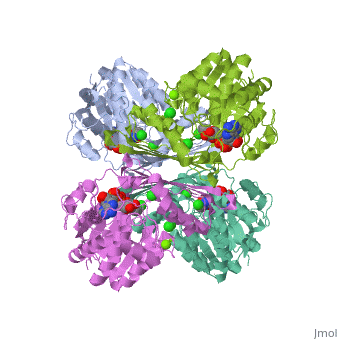Lactose Permease
Function of Lactose PermeaseFunction of Lactose Permease
Lactose Permease is a transmembrane protein that
facilitates the passage of lactose across the phospholipid bi-layer of the cell membrane. The transport mechanism used is an active co-transport that uses the inwardly directed H+ electrochemical gradient as its driving force. As a result, the lactose is accompanied from the periplasm to the cytoplasm of the cell by an H+ proton.[1]
Lactose is a disaccharide carbohydrate found primarily in mammalian milk. It is a
disaccharide composed of the monosaccharides glucose and galactose. When lactose is ingested,
it is brought into cells in the digestive system by the protein Lactose Permease. Here it is
broken down into its monosaccharide subunits by the enzyme lactase so it may be used in the
process of cellular respiration.<ref name="Gita C. Gidwani">[1]Cite error: The opening <ref> tag is malformed or has a bad name
Lactose permease is a transmembrane protien consisting of N- and C- terminal domains, each with <Scene> six transmembrane helices, symmetrically positioned within the permease. Six side chains have been determined to be irreplaceable with respect to active transport of lactose. Those which are crucial for substrate binding are <Scene> Glu126, <Scene> Arg144, and <Scene> Glu269, which may play a role in both substrate binding and proton translocation. <Scene>Arg302, <Scene>His322, and <Scene>Glu325 play essential roles in the proton translocation series of the co-transport. Two other important side chains are <scene>Cys148 and <Scene>Trp151, which are suspected to play an important role in the alignment of the galactopyranosyl end of the substrate.
These sidechains can be found within the large internal <Scene>hydrophilic cavity of the
protien. This is the active site where the substrate is recieved for transport. The
substrate, traditionally lactose, is shown <scene>here. Only the <Scene>inward-facing
conformation, in which the large hydrophilic cavity discussed previously is oriented towards
the cytoplasm, has been crystallized thus far.
ReferencesReferences
Replace the PDB id after the STRUCTURE_ and after PDB= to load and display another structure.
| |||||||||
| 3cin, resolution 1.70Å () | |||||||||
|---|---|---|---|---|---|---|---|---|---|
| Ligands: | , , | ||||||||
| Gene: | TM1419, TM_1419 (Thermotoga maritima MSB8) | ||||||||
| Activity: | Inositol-3-phosphate synthase, with EC number 5.5.1.4 | ||||||||
| |||||||||
| |||||||||
| Resources: | FirstGlance, OCA, RCSB, PDBsum, TOPSAN | ||||||||
| Coordinates: | save as pdb, mmCIF, xml | ||||||||
